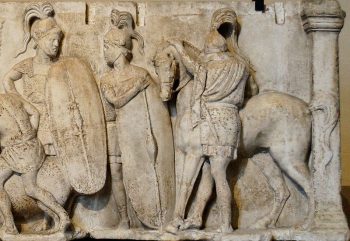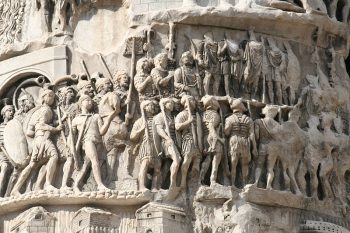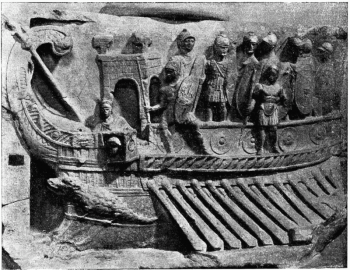The Roman Military Posted by andregurgel on Apr 19, 2019 in Intro to Latin Course, Roman culture
Note: This blog post is a companion to Unit VII of our Introduction to Latin Vocabulary course. You can learn more about the course here.
The Roman army was perhaps the most disciplined and organized in the history of mankind. It was a real fighting machine ready to destroy anyone who stood in Rome’s way. Many centuries after the fall of the Roman Empire, the emperor Napoleon made a speech to his troops in Egypt in which he said:
“The Roman legions whom you have sometimes imitated, but not as yet equaled, fought Carthage successively upon this sea and upon the plains of Zama. Victory never forsook them, because they were constantly brave, patient of fatigue, well disciplined, resolute. But, soldiers, Europe has her eyes upon you! You have great destinies to fulfill, battles to fight, fatigues to surmount!”
However, what was the key to Roman success? First, I would say organization. When an army is organized and everyone knows the role they are playing on the battlefield, that can decide the fate of any battle. Then comes strategy. No army relies entirely on force to win a battle and the Romans had great strategists like Julius Caesar and Caligula’s father, Germanicus.
Even in times of peace, the Romans were ready for war. The Roman historian Vegetius wrote in his De Re Militari that “si vis pacem para bellum” (if you want peace, prepare for war). Now let’s learn more about the Roman army and their tactics which, believe it or not, are still used today!
The Roman Infantry
The origins of the Roman army are obscure but it was perhaps based on the Etruscan or Greek model. I particularly find that there is a great similarity between the Roman legion (from Latin legio) and the Greek hoplites.
Among the Roman tactics, the most famous one is perhaps the testudo (Latin for turtle). The soldiers used their shields to create a protection which resembled a turtle’s shell. If you would like to see how it worked, I strongly recommend the film Cleopatra, starred by the amazing actress Elizabeth Taylor. However, keep in mind that, when it comes to ancient history, Hollywood films are not a reliable source!
As mentioned in our article about social classes, Roman society was based on wealth (in other words, a plutocracy). That same rule applied to the army! During the early republic, the lower classes would make the light infantry, which consisted of soldiers called hastati (after the Latin word for spear, hasta) and velites (skirmishers). Then there were the triarii, rich Roman citizens who could afford more expensive weapons like a gladius (sword) and long spears, the principes who constituted the heavy infantry, and the equites (knights) who were rich enough to buy a horse.
During the consulship of Caius Marius, the Roman army was reformed and the velites, principes and triarii were made extinct. Marius was in favor of Rome having a standing army, so he allowed anyone to join, even if they didn’t have any estate at all, as the state would pay for their weapons and even pay them a wage. This made it possible for poor Roman citizens to join the army and get part of the loot of each vanquished enemy.
After Marius’ reform, this new army was organized in legions. During the time of the Roman kings, each legion had six thousand men (including legionaries and supporting staff, like doctors), but the Third Century A.D this numbers decreased to a thousand men. Then there was the cohort (from Latin cohors) which had between three hundred and eight hundred soldiers. The cohort would be divided into centuries led by a centurion (after the Latin word centum, one hundred), which, in turn, were divided into decuries, led by a decurio, after the word decem (ten).
If the Marian Reforms revolutionized the Roman Army, Marius insisted that the soldiers carry their own equipment rather than having slaves or animals do it. As a result, the soldiers started calling themselves Marian mules!
The Roman Navy
The Romans were never fond of the sea. Unlike other civilizations, such as the Greeks and Egyptians, the sea wasn’t their specialty, so they preferred facing their opponents on dry land. On the other hand, money and power were a strong incentive to make the Romans want to build a powerful navy. It was thanks to their seafaring allies, like the Greeks, that the Romans developed the technology to build their own navy. Years later, the expertise of the magistri navis (admirals) was decisive in the wars against Carthage. Even Julius Caesar realized that he needed a well-equipped navy after launching a campaign against the pirates.
However, what was the secret of the Roman navy’s success? Scholars believe that it was thanks to a boarding device called a corvus (Latin for raven). It worked like a bridge with a metal prong that could be dropped onto enemy ships. Once the two ships were tied, the Romans could use the ships as platforms for fighting. In other words, they would turn a sea battle into a land battle!
Serving in the Roman navy was probably not as well thought of as serving in the legions, but it was thanks to the navy that the Romans defeated their greatest rival, Carthage, and could call the Mediterranean mare nostrum (our sea).
Auxilia
The etymology of auxilia is from the Latin word auxilius (help, aid). They consisted of allies who could join a unit of non-Roman citizens. There was a lot of bad blood among Iberian tribes, German tribes, Gauls and other peoples which were considered barbarians by the Romans. Then the Romans would promise that, if they joined the auxiliary troops, they would get revenge on their enemies and receive part of the loot. They were also called peregrini (outsiders). If you would like to learn more about this Roman social class, see our article about Roman social classes.
At first, the auxiliary troops weren’t organized, but after 200 BC they became a standing corps of the Roman army. Their structure was very similar to the regular army but the terminology was different:: ala (cavalry), cohors peditata (infantry) and cohors equitata (mixed cavalry and infantry). They had their own special soldiers like Balearic slingers, Cretan archers, and Numidian light cavalry.
The auxilia corps was considered barbarian by Roman citizens but, when military service was over, they were granted Roman citizenship and the army would give them tracts of land and, in some cases, money.
Just imagine what the Romans could have achieved if they had had an air force as well! Roman tactics are still studied and implemented today, especially by the police when facing riotous crowds. So whenever you see a riot on the TV news, think about the testudo.
Glossary of Latin Terms
si vis pacem para bellum” (if you want peace, prepare for war)
hastati– heavy infantry employed during the early republic.
velites- skirmishers. Light infantry during the early Roman Republic
triarii- Spearmen of the pre-Marian armies, equipped with the Hasta, who formed the third line of battle behind the Principes.
principes- spearmen, and later swordsmen. They were the heavier infantry of the legion. Equipped with large shields and wore good quality armor.
centurio- Roman commander who led one hundred men.
magistri navis- admirals
corvus- boarding device used by the Roman navy.
mare nostrum– our sea. How the Romans called the Mediterranean
ala cavalry of auxiliar troops
cohors peditata auxiliar troops infantry
cohors equitata mixed cavalry and infantry in the auxiliar troops.
peregrini– free non-Roman citizens
testudo- battle formation resenbling a turtle

Build vocabulary, practice pronunciation, and more with Transparent Language Online. Available anytime, anywhere, on any device.






